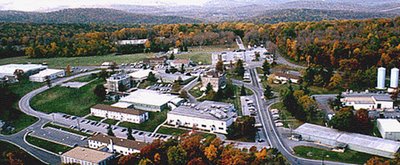Squatter-Mimicry

[Image: Kibera, in Nairobi, Kenya is one of the largest slums in Africa. Photo by SIMON MAINA/AFP/Getty Images]
Business Week has a short interview with Stewart Brand, whose recent research is focused on how the world's squatter cities are serving as centers of entrepreneurship and innovative design. The bulk of his message, (of which he has presented in numerous city conferences entitled ‘City Planet’, and is revealed in a long piece he published in a recent issue of Strategy + Business), in essence, describes the incredible pace of change facing the planet undergoing hyper-urbanization, and how cities reveal an evolutionary societal spirit in terms of the ways nature and civilization have - and go on - mutually shaping one another through out history.

[Image: Squatters in Bombay provide low-cost pots to restaurants through out the city. Photo by SEBASTIAN D'SOUZA/AFP.]
In short, Stewart is optimistic about an urban future, arguing that cities have a smaller footprint than rural development and therefore have the potential to be more compatible with environmental justice, and, particularly how squatter cities can be overlooked as critical mechanisms for the triumph of global poverty over rampant and helpless urban slumification.
Alex Steffen noted these thoughts from one of his talks, and wrote for Worldchanging:
“In asking himself how cities "learn" over time in the way that buildings do, Stewart found that while cities do learn, they also teach: they teach civilization how to be civilized.” [...] Stewart argues that the "squatter cities" which form in rapidly-urbanizing areas are among the most vital parts of the 21st century city. He asserts that these global slums and shantytowns are, for most residents, temporary, that pockets of urban poverty are transitions from even worse rural poverty to a better existence in the city. Squatter cities are usually self-constructed and self-organized, better reflecting the needs of the residents than government-built housing; they're also engines of community, where support is provided by extended family, neighbors and religious institutions."
In this interview, Brand himself says, “What's interesting is that nations have figured out that squatters simply aren't going away. They're realizing they have to be finessed rather than crushed.” He then compares the social movement of a squatter sustainability, to the open-source culture of the high-tech world. He says, “The street finds uses for things. The Internet is rife with things people are doing for free. […] Squatters operate in the same way. Just getting by takes a lot of creativity. And now nations and businesses are seeing, perhaps thanks to the open-source movement, that everything that isn't a crime has an application.”
Of course, if you want a vast and vivid account of this squatter sustainability and the nature of entrepreneurship that is vital to the survival of these communities, Robert Neuwirth’s book is an amazing account. I am reminded of this statement he wrote on his blog not long ago: “Pretty much every squatter is an impoverished entrepreneur. Primitive proto-capitalism may not be fashionable, but it is one way to move squatter communities forward.” He also links to a report by Muhammad Yunus, titled ‘ELIMINATING POVERTY THROUGH MARKET-BASED SOCIAL ENTREPRENEURSHIP’, which is a valuable read.

[Image: Kibera, Kenya. Photo by SIMON MAINA/AFP/Getty Images.]
Reena Jana, whom interviews Brand, asks some good questions: how squatter communities might provide useful models for other contexts of needed self-construction, like disaster response; how squatters could be trend setters for a future world where resource is scarce, where government assistance is meager, where density is overwhelming, and where communities will need to become increasingly independent and entrepreneurial for their own survival. The article veers more towards an interest in how the informal economy is, or perhaps will more so in the future, serve and intersect with the formal economy, and how businesses should be looking to find more ways of working with squatter communities.

[Image: Erecting shelters near Manila, where often times the environment alone is the biggest hazard for squatters. Photo by JOEL NITO/AFP/Getty Images.]
I wish Brand’s responses explored more deeply specific models squatters are devising by and for themselves; examples of a truly self-sustainable and self-reliant model of community building, independent progress, that doesn't require outside financial or infrastructural assistance. Pure squatter innovation.

[Image: Scavaged housing in Dhaka, Bangladesh. Photo by FARJANA K. GODHULY/AFP/Getty Images.]
Indeed, squatters are some of the most resourceful people on the planet. For a good read with a lot of relevant resources on this topic of a squatter urbanism, check out this interview I did with Wes Janz, an architect and educator who has been working with deprived communities for years, following a sort of build to learn philospophy, whereby the squatters and refugees are understood as providing the architectural lessons of the future.
Also, check out Renu Khosla, who registers an official presence for slum dwellers in Delhi, by marking their existence down in chalked renditions of place and occupancy on the sidewalks. There's Jockin Arputham, head of the National Slum Dwellers Federation and Slum Dwellers International, who, as Neuwirth describes, is the world's only squatter philosopher. He "applies the tools of capitalism to a critique of capitalism. He sees savings as the salvation of the urban poor." In his model, "each squatter community that joins the federation creates a savings association." This allows communities to pool their money, which is returned to them in the form of small business loans, with very cheap interest rates. The results in India have been amazing, and only confirms that the agents of change for the urban poor are - and will be - the urban poor themselves.
Also, a great quote found in Shadow Cities, from a journalist describing the squatter homes in the early days of New York: "The shanty is the most wonderful instance of perfect adaptation of means to an end in the whole range of modern architecture. Nothing is prepared for it, neither ground for material. Its builders have an empirical knowledge of the craft they practice. They scorn a model, and they work with whatever comes to hand."
Given the unpredictable landscape of contemporary global urbanism, challenged by dramatic shifts in climate change and a spike in devastating natural disasters, the economic pressures of globalizationon on labor markets, the world economy and its translation to inaccessible real estate markets all over, and, given what seems the United States' heightened capacity to respond to any event only in terms of a security threat rather than with the needed compassion and capacity for true emergency relief and efficient long term disaster response planning, not to mention the decline of the middle class through out the First world, the increasing global divide between the developed world and a Third world trapped behind a threshold of borderzones, immigration surveillance scapes, and hyper-militarized buffer zones, we may all of us one day find ourselves standing on one side of a set of bars or another; that is, either isolated behind the iron clad bubble of a swollen gated community, or behind a flexible border fence that moves and adapts to an alteration in border territory disputes and land occupations, tactical annexations made ambiguous by perpetual conflict, a stasis grounds of hyper-migration, and the landscape rise of temporary camp-ification. It may very well spell a future world where the squatters and refugees will be the leaders of a self-sustainable revolution, a bottom-feeders' guide to survival and the retooling of cities on a global scale. It may be those very same principles of self-mobilization and scavenge that will save urbanization from itself.
Almost identitcal to something I wrote at the end of the Janz interview, Brand makes this righteous statement and coins a term I had not heard before. “Perhaps soon we'll be looking to squatter cities for design ideas, much as we looked to biology. Rather than bio-mimicry, we'll be considering squatter-mimicry.”





































